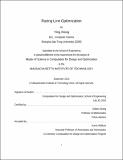| dc.contributor.advisor | Gilbert Strang. | en_US |
| dc.contributor.author | Xiong, Ying, S.M. Massachusetts Institute of Technology | en_US |
| dc.contributor.other | Massachusetts Institute of Technology. Computation for Design and Optimization Program. | en_US |
| dc.date.accessioned | 2011-06-24T13:27:55Z | |
| dc.date.available | 2011-06-24T13:27:55Z | |
| dc.date.copyright | 2010 | en_US |
| dc.date.issued | 2010 | en_US |
| dc.identifier.uri | http://hdl.handle.net/1721.1/64669 | |
| dc.description | Thesis (S.M.)--Massachusetts Institute of Technology, Computation for Design and Optimization Program, 2010. | en_US |
| dc.description | This electronic version was submitted by the student author. The certified thesis is available in the Institute Archives and Special Collections. | en_US |
| dc.description | Cataloged from student-submitted PDF version of thesis. | en_US |
| dc.description | Includes bibliographical references (p. 112-113). | en_US |
| dc.description.abstract | Although most racers are good at controlling their cars, world champions are always talented at choosing the right racing line while others mostly fail to do that. Optimal racing line selection is a critical problem in car racing. However, currently it is strongly based on the intuition of experienced racers after they conduct repeated real-time experiments. It will be very useful to have a method which can generate the optimal racing line based on the given racing track and the car. This paper explains four methods to generate optimal racing lines: the Euler spiral method, artificial intelligence method, nonlinear programming solver method and integrated method. Firstly we study the problem and obtain the objective functions and constraints for both 2-D and 3-D situations. The mathematical and physical features of the racing tracks are studied. Then we try different ways of solving this complicated nonlinear programming problem. The Euler spiral method generates Euler spiral curve turns at corners and it gives optimal results fast and accurately for 2-D corners with no banking. The nonlinear programming solver method is based on the MINOS solver on AMPL and the MATLAB Optimization Toolbox and it only needs the input of the objective function and constraints. A heavy emphasis is placed on the artificial intelligence method. It works well for any 2-D or 3-D track shapes. It uses intelligent algorithms including branch-cutting and forward-looking to give optimal racing lines for both 2-D and 3-D tracks. And the integrated method combines methods and their advantages so that it is fast and practical for all situations. Different methods are compared, and their evolutions towards the optimum are described in detail. Convenient display software is developed to show the tracks and racing lines for observation. The approach to finding optimal racing lines for cars will be also helpful for finding optimal racing lines for bicycle racing, ice skating and skiing. | en_US |
| dc.description.statementofresponsibility | by Ying Xiong. | en_US |
| dc.format.extent | 114 p. | en_US |
| dc.language.iso | eng | en_US |
| dc.publisher | Massachusetts Institute of Technology | en_US |
| dc.rights | M.I.T. theses are protected by
copyright. They may be viewed from this source for any purpose, but
reproduction or distribution in any format is prohibited without written
permission. See provided URL for inquiries about permission. | en_US |
| dc.rights.uri | http://dspace.mit.edu/handle/1721.1/7582 | en_US |
| dc.subject | Computation for Design and Optimization Program. | en_US |
| dc.title | Racing line optimization | en_US |
| dc.type | Thesis | en_US |
| dc.description.degree | S.M. | en_US |
| dc.contributor.department | Massachusetts Institute of Technology. Computation for Design and Optimization Program | |
| dc.identifier.oclc | 706825301 | en_US |
